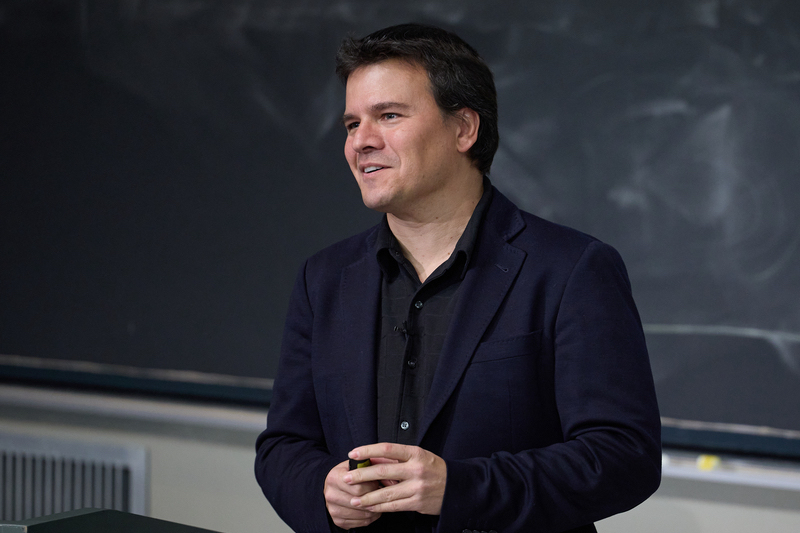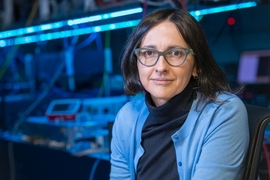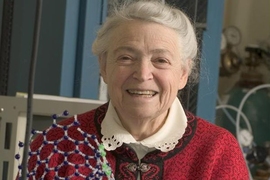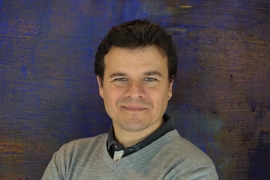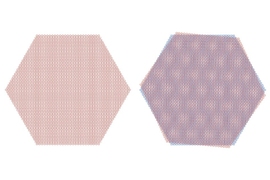“We have barely scratched the surface of the moiré quantum matter universe,” said Pablo Jarillo-Herrero at the 2022 Mildred S. Dresselhaus Lecture. The Cecil and Ida Green Professor of Physics at MIT, Jarillo-Herrero is at the forefront of the scientific exploration into moiré quantum systems, where correlated physics, superconductivity, and other phases of matter can be studied with unprecedented tunability.
Delivered on Nov. 22, Jarillo-Herrero’s lecture introduced a combined in-person and virtual audience of over 200 to magic-angle graphene, the rise of moiré quantum matter, and what comes next, with a bit of inspiration from the late MIT Institute Professor Mildred Dresselhaus.
“I’m a great fan of Millie, and it’s really a great honor to have been selected,” Jarillo-Herrero began, explaining that he chose to study carbon nanotubes for his PhD after reading the book “Science of Fullerenes and Carbon Nanotubes,” co-authored by Dresselhaus and two others. Fast forward a decade, and Jarillo-Herrero was co-hosting Dresselhaus’ 80th birthday party at MIT. “I never imagined I would be a colleague of Millie. Her office was just upstairs from mine,” he noted, glancing upward. “I would always be sitting there thinking, ‘What would Millie do?’”
Investigating strongly correlated quantum materials
There are two traditional platforms to investigate quantum materials, said Jarillo-Herrero. Physical materials made of atoms periodically positioned in lattices spaced at the scale of 1 angstrom (0.1 nanometers), and cold atoms trapped in optically induced lattices where the typical space between atoms is 1 micron (1,000 nanometers). As of 2018 there is also a third platform that falls neatly in the middle — moiré quantum matter.
Over the past few years, using moiré quantum matter as a platform for tuning atomic interactions, physicists have realized many, if not all, of the phases of condensed matter physics — correlated insulators, topological phases, nematicity, superconductivity, magnetism, moiré ferroelectricity, and strange metals, among others — using just two or three sheets of two-dimensional materials (just one atom thick) stacked on top of each other.
Introducing magic angle graphene
Graphene is one such 2D material, consisting of a single layer of bonded carbon atoms. A stack of graphene sheets with the atomic directions of each sheet perfectly aligned forms graphite — the material used in pencils. Jarillo-Herrero’s breakthrough was to ask, “What happens if you put graphene on top of graphene and rotate it?”
The answer, in real space, is that you form a moiré pattern, as the atoms in the top graphene sheet now only occasionally match the positions of the atoms in the bottom graphene sheet. Depending on the angle, the periodicity at which the atoms of the two graphene layers match each other will change. At a “magic” twist angle of 1.1 degrees, the system of two graphene sheets becomes a platform to explore the workings of the universe.
“When you make these devices, then the magic starts to happen,” Jarillo-Herrero explained. At that particular twist angle of two pieces of graphene, and at a certain doping density (in particular, two electrons per moiré unit cell), the system becomes a correlated insulator, Jarillo-Herrero explained. Then, add just a fraction more of electrons per moiré unit cell, and the system goes from insulator to superconductor.
The theory tsunami
After the 2018 discovery of superconductivity in magic angle graphene by a team led by Jarillo-Herrero, the scientific world dove into moiré quantum matter with deep focus.
In addition to successfully reproducing the results of Jarillo-Herrero’s group, physicists all over the world started measuring the critical temperature at which superconductivity is initiated, testing what happens when you apply pressure to the device, and even creating quantum twisting scanning tunneling microscopes. Since then, several other correlated systems have been discovered, such as magic angle twisted trilayer graphene, the strongest superconductor in the world, reported by Jarillo-Herrero in 2021.
“One of the biggest satisfactions for me,” he said, “is that this moiré quantum matter has meant the merging of several modern condensed matter physics communities — 2D van der Waals materials and heterostructures, strongly correlated materials, and topological condensed matter physics. All of these types of physics and systems come together in moiré quantum matter.”
Moiré magic beyond graphene
The same engineering trick of using crystal symmetry can be applied to many other stacked 2D materials, explained Jarillo-Herrero. He described recent findings involving ferroelectricity in bilayer boron nitride, where his group made a ferroelectric out of something that is not ferroelectric. By breaking the natural, 180-degree stacking of hexagonal boron nitride and stacking it instead at 0 degrees, they created a switchable ferroelectric that can operate at room temperature and is robust and stable.
In addition, moiré magic is expanding beyond twisted 2D materials. Physicists are investigating twisted cold atoms lattices, twisted phononics, twisted photonics that could slow down the speed of light, twisted electrochemistry and catalysis, and even moiré gravity.
After his talk, Jarillo-Herrero answered audience questions about minimal feature size, the next materials to stack, and practical applications.
“It does seem that every moment of the day, every month, there is yet another angle to be pursued in the twisted options of the moiré solids,” said Vladimir Bulović, the director of MIT.nano and Fariborz Maseeh Professor of Emerging Technology. “If you can imagine one day that there’s a 2D materials foundry sitting in MIT.nano, what do we start seeing?”
“There is a barrier in terms of how easy it is to make the devices,” responded Jarillo-Herrero. “If we had a quantum foundry that would automate many of the pieces and the processes that are involved in making these structures reliably, with high reproducibility, and all identical, I think it would vastly expand the basic science. We have infinite possibilities; doing them manually is very costly. If we could make hundreds of variations, we would advance very far in terms of possibilities for applications.”
Honoring Mildred S. Dresselhaus
Jarillo-Herrero was the fourth speaker to deliver the Dresselhaus Lecture, an annual event organized by MIT.nano to honor the late MIT physics and electrical engineering professor Mildred Dresselhaus. The lecture features a speaker from anywhere in the world whose leadership and impact echo Millie’s life, accomplishments, and values.
In closing, Jarillo-Herrero shared a quote by Millie that was also shared at the 2019 inaugural lecture by Cornell University Professor Paul McEuen: “Follow your interests, get the best available education and training, set your sights high, be persistent, be flexible, keep your options open, accept help when offered, and be prepared to help others.”
